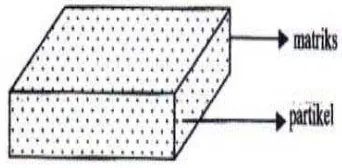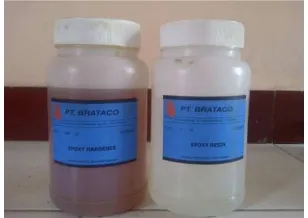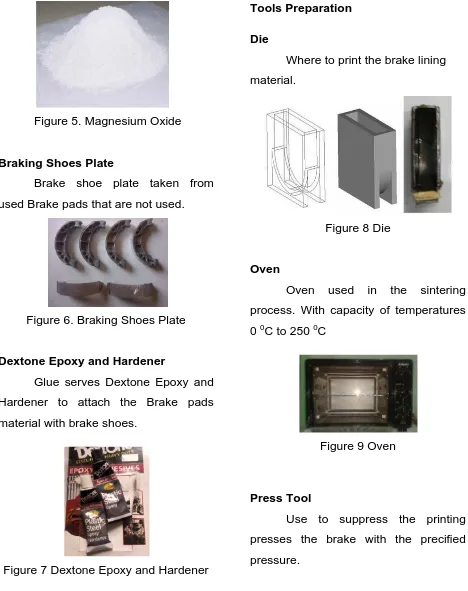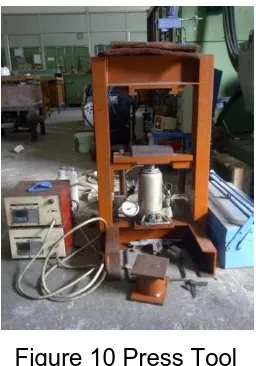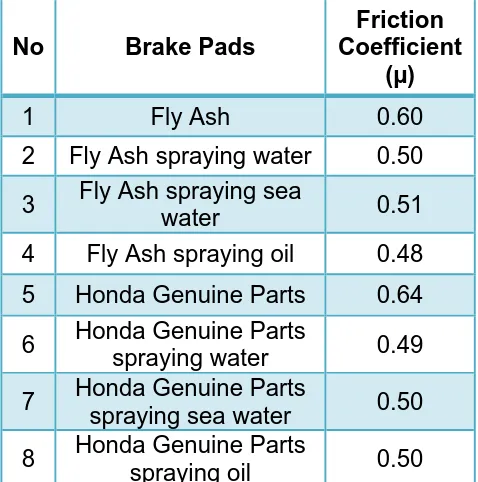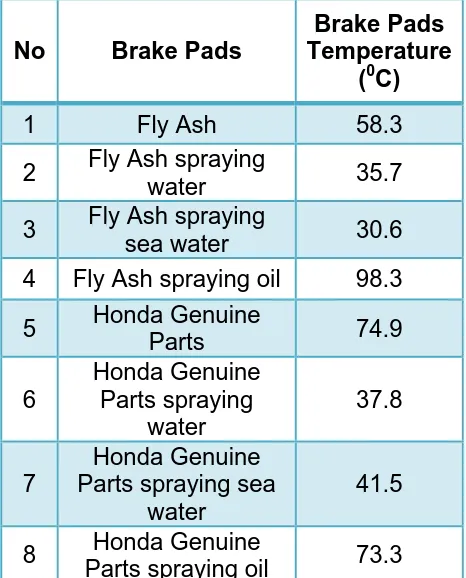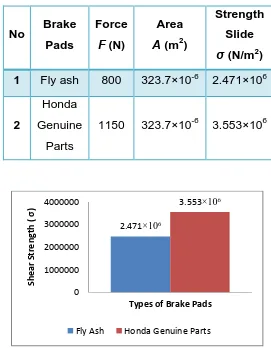THE STUDY OF FRICTION COEFFICIENT, BRAKE
PADS TEMPERATURE AND ADDHESIVE RESISTANCE
ON BRAKE PADS USING FLY ASH COAL
PUBLICATION ARTICLE
Submitted as a Partial Fulfillment of the Requirements for GettingBachelor Degree of Engineering in Automotive Department
Arranged by:
Agus Syafaruddin
D 200 090 210
MECHANICAL ENGINEERING DEPARTMENT
INTERNATIONAL PROGRAM
IN AUTOMOTIVE/MOTORCYCLE ENGINEERING
MUHAMMADIYAH UNIVERSITY OF SURAKARTA
APPROVAL
The Final Project entitles “The Study of Friction Coefficient, Brake Pads
Temperature and Addhesive Resistance on Brake Pads Using Fly Ash Coal” has been approved by Supervisors and authorized by Secretary of
International Program as partial fulfillment of the requirements for getting the
Bachelor Degree of Engineering in Automotive Department of
Muhammadiyah University of Surakarta.
Written by:
Name : Agus Syafaruddin
NIM : D 200 090 210
Has approved and legalized on:
Day :
Date :
Supervisor I Supervisor II
(Supriyono, ST, MT, Ph.D) (Wijianto, ST, M. Eng. Sc)
Admitted by,
Secretary of International Program
THE STUDY OF FRICTION COEFFICIENT, BRAKE PADS TEMPERATURE AND ADDHESIVE RESISTANCE ON BRAKE PADS
USING FLY ASH COAL
Agus Syafaruddin
Automotive Engineering Department of Muhammadiyah University of Surakarta Jln. A. Yani Pabelan, Kartasura, Tromol Pos I, Telp. (0271) 715448 Surakarta
Email: [email protected]
ABSTRACT
Abstract:
Brake pads are one component of a motor vehicle which is used to slow or stop the vehicle. When at high-speed vehicle brake has a very important role. The purpose of this study was to investigate the influence of the environment in the form of spraying with water, sea water, and oil to the friction coefficient of the brake pads and investigate adhesion resistance resulting of a break from the manufacture of brake pads Fly Ash compared with Honda Genuine Parts brake.
This research was conducted by mixing ingredients brake pads according to a predetermined composition, press the brake pads with a load
of 3 tons for 30 minutes, then heated to a temperature of 120 0C for 30
minutes. The method is performed in testing the friction coefficient is based on the standard ASTM C1028. To determine the value of the resistance of glue or adhesive shear loads due to the brake pads using the ASTM D3737 standard, in place on the die according to ASTM standard D905. Analysis is conducted after got data of testing result.
The results showed that the friction coefficient brake Honda Genuine Parts at 0.64µ while the friction coefficient brake Fly Ash of 0.60µ. But the brake condition given spraying water, sea water, and oil brake Fly Ash is better than Honda Genuine Parts. From the test results and the calculation of shear strength indicates that the brake pads Fly Ash not better than the Honda Genuine Parts brake. This is evidenced from the results of testing the
shear strength of Honda Genuine Parts brake at 3.552×106 (N/m2) while the
brake Fly Ash at 2.471×106 (N/m2).
Background
The developments of technology
in various fields are very rapidly,
especially in the automotive fields. With
the development of vehicle
performance, it is necessary to get an
effective braking system and also the safety in vehicles.
The use of asbestos in the
manufacturing of brake pads is not
environmentally friendly, because it has
a negative impact on health. As with
previous studies of brake pads
motorcycle can be made by utilizing
waste fly ash coal as an amplifier and
Epoxy Resin and Magnesium Oxide
(MgO) as a matrix. Besides to
environmentally friendly, fly ash also has
advantages in terms of lower cost
production than brake pads made of
asbestos.
In this study, fly ash is selected
as a material used to manufacture the
brake pads, because Fly ash has good
chemical properties of pozzolanic and
physical properties of low porosity and
fine particle.
Problem Statement
Problem statement that can be
drawn from the problem above is how
the effect of variations in the
composition brake shoes made from flay
ash coal, Magnesium Oxide (MgO), and
epoxy resin.
Objectives
1. Investigate the use of fly ash coal
as a substitute for asbestos in the
manufacture of brake pads.
2. Investigate environmental factors
of brake pad performance by
spraying with water, sea water and
oil.
3. Investigate the adhesive resistance
of brake pads due to shear loads
between brake pads connection
and brake shoes using Dexton
Plastic Steel Epoxy as connectivity
material.
Literatures Review
Isak, Bukhori. A, (Final Project
2013), “Analysis and manufacturing
composite for brake shoes of motorcycle
Honda supra x 125 cc using fly ash coal,
and magnesium oxide with epoxy
matrix”. From Brinell hardness test
results generated that hardness
resulting from brake shoes variation has
variation 2 has a value of 14.8 BHN
more great than brake shoes Honda
Genuine Parts has a value of 12.3, while
for Variation 3 has a value of 10.2 BHN
and Variation 4 has value 8.9 BHN is
smaller than Honda Genuine Parts
brake shoes.
Tri, H.U (final project 2010),
“Pengaruh lingkungan terhadap
keausan, daya, koefisien gesek, suhu
kampas rem, dan waktu pengereman
kampas rem berbahan fiberglass”. The
results showed that the dry conditions,
brake that uses glass fiber (fiberglass)
21.4% more wear resistant, spraying oil
at 23.8% more resistant to wear, the
brake fluid spraying over 29.4% of wear
on the brake indopart, while the
spraying conditions, water brake
indopart 38% more resistant to wear
and the condition of the sea water
spraying 25% more wear resistant than
the epoxy fiber brake lining. Hardness
value is equal 20.4HB fiber epoxy.
Basic Theory
Particulate Composites
Particulate composites using a
composite powder particles as
reinforcements and evenly distributed in
its metric.
Figure 2. Particulate Composite
Sintering
Sintering is a method of making
the material of powder by heating the
particles to form a bond. Sintering is the
bonding together of particles at high
temperatures. Sintering can occur below
the melting temperature (melting point).
During the sintering process of
the merger will occur between the
particles, so that each binding. In the
sintering process, there will be a
process of movement between powder
particles on the surface of the powder.
The most important equipment in the
sintering process is sintering kitchen.
This kitchen must be able to regulate
the temperature, heating time, heating
rate, and the environment in the kitchen
Material Preparation Fly Ash Coal
Fly ash is the fine particles that
are precipitated from the burning pile of
coal powder, the amount is quite large,
so it requires a management that does
not cause environmental problems such
as air pollution, water and ecosystem
degradation.
Figure 3. Fly Ash Coal
EPOXY RESIN
Epoxy is a thermoset polymer
type, the plastic cannot be recycled.
Epoxy resins are composed of two
materials, namely epoxy resin and
hardener or curing agent
Epoxy resins are thermosetting
plastics including group, which is no
longer melt when heated. The hardening
occurs due to the polymerization
reaction, not freezing. The system
consists of two components of the resin
and curing agent are mixed at the time
will be used.
Figure 4. Epoxy Resin and Hardener
MgO (MAGNESIUM OXIDE)
MgO (Magnesium Oxide) is a
material that is very lightweight metal
structure, MgO chosen as a filling
material that also serves as an abrasive
and amplifier because it has good
characteristics. In addition, magnesium
oxide as a wetting agent that makes the
bond between Alumina and Aluminum is
strong, not easily eroded surface.
Although a small percentage of MgO
powder an important role because they
have the ability to charge any difference
in height of the rough surface and lower
the interfacial tension. Wear resistance
can be improved through the addition of
Figure 5. Magnesium Oxide
Braking Shoes Plate
Brake shoe plate taken from
used Brake pads that are not used.
Figure 6. Braking Shoes Plate
Dextone Epoxy and Hardener
Glue serves Dextone Epoxy and
Hardener to attach the Brake pads
material with brake shoes.
Figure 7 Dextone Epoxy and Hardener
Tools Preparation
Die
Where to print the brake lining
material.
Figure 8 Die
Oven
Oven used in the sintering
process. With capacity of temperatures
0 0C to 250 0C
Figure 9 Oven
Press Tool
Use to suppress the printing
presses the brake with the precified
Figure 10 Press Tool
Non-contact Infrared Thermometer
Non-contact Infrared Thermometer
is used to measure the temperature and
the Brake pads, drum with a capacity of
-50 0C to 500 0C.
Figure 11 Non-contact Infrared
Thermometer
Vernier Caliper
Vernier Caliper is used to
measure the height of the canvas on the
brakes before and after the test.
Figure 12 Vernier Caliper
Scales
Measure the mass of the load
and the pendulum is used for testing the
friction coefficient.
Figure 13 Scales
Friction coefficient
The friction coefficient is a scale
that indicates the level of the surface
roughness of an object when both
objects were rubbing. Mathematically,
the friction coefficient is defined as the
ratio between the number results with
the magnitude of the frictional force to
normal force on an object. So the friction
coefficient is determined by two factors,
namely the level of roughness of the two
fields of touch and the normal force
acting on the object. The magnitude of
the normal force acting on an object is
proportional to the weight of the object,
because the object only works
contained gravity on its surface. So that
mathematically, the magnitude of the
N = w = (m.g)
The friction coefficient is
symbolized by the Greek letter µ, which
is a small-scale value-dimensional
frictional force that explains the
comparison between the two parts and
both compressive forces.
Basic friction coefficient formula (µ):
N
F
=
µ
Where:
F = Friction force (Newton)
N = Normal force (Newton)
Friction brakes on canvas
influenced the amount of rounds it is
necessary to find the torque produced.
Moment T is absorbed by the brake
drum, then:
Glue Strength Testing
In this study, using the testing
tools compression test. Testing the
strength of the glue using standards
ASTM D3737. ASTM D3737 method is
to determine the value of vertical shear
force carried out on the material layer
attached to the glue. When testing the
strength of the glue specimen (drum
brake) in place on the die / mold that
has been designed according to the
standard ASTM D905. ASTM D905 is a
reference to lock the brake when the
shear strength testing.
Brake shear strength can be
calculated by the formula:
Where:
σ = The maximum shear strength in units (N/m2)
F =The maximum compressive
force to brake off (N)
METHODS
Flowchart of Research
Epoxy resin Hardener Epoxy resin Magnesium
Oxide
Fly Ash
Glue Strength Testing Based on ASTM Standard D3737
Coefficient of Friction Testing based on ASTM Standard C1028
Testing Results
Retrieval of data
Analysis and Discussion of Friction Testing and Testing Specimens press
Conclusion
END Mixing Materials
Pressing (3 ton along 30 minutes)
Sintering (1200 C along 30 minutes)
Specimens
AHM Testing
Library Studies and Field Studies
Procurement of Equipment
Procurement of Materials
Preparation of Material
Result of Testing Analysis
Results Calculations Friction Coefficient
In this experiment, the method is
performed in the friction coefficient
testing based on ASTM C1028. ASTM
C1028 Standard sets out methods for
testing the friction coefficient.
Table 1 The Results of Calculations of
Friction Coefficient
6 Honda Genuine Parts
spraying water 0.49
7 Honda Genuine Parts
spraying sea water 0.50
8 Honda Genuine Parts
spraying oil 0.50
Figure 14 The Relationship between Graphs
with has given a type Brake Pads Friction
Coefficient Effect against Environmental.
From the results of the coefficient
of friction brake pads, in dry conditions
or without any effect spraying brake
pads Honda Genuine Parts brake pads
are better than the fly ash material. This
proved from the value of the coefficient
of friction brake pads Honda Genuine
Parts at 0.64 while the coefficient of
friction brake pads Fly Ash at 0.50.
But brake pads with spraying
water and sea water, Fly Ash brake
pads are better. This is proved from
brake pad friction coefficient Fly Ash
respectively in 0.50 and 0.51 waters
spraying conditions and sea water
spraying conditions, while the value of
the coefficient of friction of the brake 0.60
dry water sea water Oil
pads Honda Genuine Parts in water
sprays and sea water spray conditions
amounting 0.49 and 0.50.
In conditions of spraying oil,
brake pads Honda Genuine Parts brake
pads are better than Fly Ash. It is shown
from the value of the friction coefficient
is equal to Honda Genuine Parts 0.50 in
oil spraying conditions, while the value
of the coefficient of friction brake pads
Fly Ash at 0.48.
The Results of Temperature brake pads
Table 2 The results of the study average
brake pads Parts spraying sea
water
41.5
8 Honda Genuine
Parts spraying oil 73.3
Figure 15 Relationship between Graphs with
Given Brake Pads type Environmental Effect
of Temperature Brake Pads.
From the experimental results of
the final temperature of brake pads,
overall brake pads Fly Ash is better.
This is shown well in dry conditions, as
well as wet conditions in water spraying
conditions, sea water and oil. This is
proved from brake pad temperature of
58.3 0C Fly Ash in dry conditions, 35.75 0
C in water spraying conditions, 30.675 0
C in seawater spraying conditions and
98.3 0C in oil spraying conditions. 58.3
dry water sea water Oil
Figure 16 Relationship between Graphs with
Given Brake Pads type Environmental Effect
of Temperature Brake Pads.
From the experimental results of
the final temperature of brake pads,
overall brake pads Fly Ash is better.
This is shown well in dry conditions, as
well as wet conditions in water spraying
conditions, sea water and oil. This is
proved from brake pad temperature of
brake pad temperature while Honda
Genuine Parts at 74.9 0C in dry conditions, 37.875 0C in water spraying conditions, 41.55 0C in sea water spraying conditions and 73.3 0C in oil spraying conditions.
Results Strength Glue Slide
The Test of strength of the glue is
using standards ASTM D3737. When
testing the strength of the glue, the
specimen is placed in the die / mold that
have been designed according to the
standard ASTM D905. ASTM D905 is a
reference to lock the brake pads when
the shear strength testing.
Table 3 Research Strength Glue Slide
Figure 17 The Relationship Between Graph
Results Type Brake Pads Slide Against
Strength Glue.
This test will determine the viscosity
of resistance to shear loads that supplied
Fly Ash brake pads with Honda Genuine
Parts brake pads for comparison. 2.471×106
dry water sea water Oil
T
From the test results and the
calculation of shear strength indicates that
the brake pads Fly Ash not better than the
Honda Genuine Parts brake. This is
evidenced from the results of testing the
shear strength of Honda Genuine Parts
brake at 3.552×106 (N/m2) while the brake Fly Ash at 2.471×106 (N/m2).
CONCLUSION
Based on the results of research
that were conducted, we can take some
of the conclusions that can be discussed
and finally this study it can be
concluded:
1. Fly ash can be used as a substitute
for asbestos in the manufacture of
brake pads. This is evidenced by
the results of testing friction
coefficient is given effect by
spraying water, sea water, and the
oil has a value greater than the
friction coefficient brake pads
Honda Genuine Parts.
2. From the research conducted, it
can be seen that for the overall
temperature of Fly Ash brake pads
better than Honda Genuine Parts
brake pads.
3. For the compressive strength test
results brake pads Fly Ash by
using glue Dextone epoxy and
hardener declared unsafe if used in
severe braking conditions, because
damage to the bonding connection.
As for gluing Honda Genuine Parts
brake pads declared safe if used
under conditions of heavy braking
and light weight.
REFERENCES
Harun and Waskito (2007), “Peningkatan Standar Kanvas Rem Kendaraan Berbahan
Baku Asbestos dan Non Asbestos (Celulose) Untuk Keamanan”. Undip –
http://alekkurniawan.blogspot.com/2009/05/kampas-rem-berbahan-serbukkayu-dan.html = kampas-rem-berbahan-serbuk-kayu-dan.
http://evasitumorang.blogspot.com/2012/10/teori-koefisien-gesekan.html
Isak, Bukhori. A, (Final Project 2013), “Analysis and manufacturing composite for brake
shoes of motorcycle Honda supra x 125 cc using fly ash coal, and magnesium
oxide with epoxy matrix”. Final Project
Ridwan, 2009, Sistem Pengereman, Diaskes 10 januari 2010 dari
http:/www.otomotif.web.id/system-rem-a42.html.
Sardi, 2009, Definisi Rem, http:/www.google.com/rem/Sardi zone.html.
Suga, Kiyokatsu dan sularso., 1997., Dasar Perencanaan dan Pemilihan Elemen
Mesin., Pradnya Paramita, Jakarta.
Tri, H.U (final project 2010), “Pengaruh lingkungan terhadap keausan, daya, koefisien
gesek, suhu kampas rem, dan waktu pengereman kampas rem berbahan
